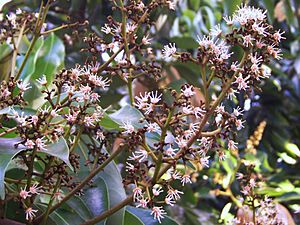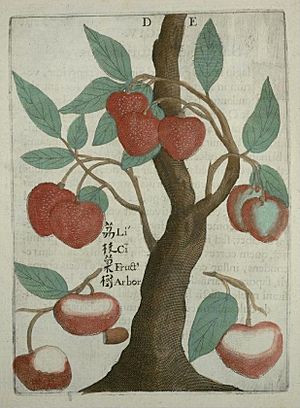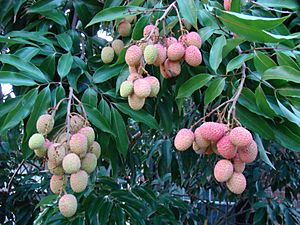Lychee facts for kids
Quick facts for kids Lychee |
|
|---|---|
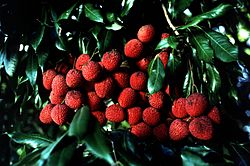 |
|
| Lychee branch with ripe fruit | |
| Scientific classification | |
| Kingdom: | |
| Division: | |
| Class: | |
| Order: | |
| Family: | |
| Genus: |
Litchi
|
| Binomial name | |
| Litchi chinensis |
|
A lychee (say it: LEE-ji) is a sweet, juicy fruit that grows in warm, wet places, also known as tropical areas. It comes from southern China. Because it's a tropical fruit, it needs a warm and humid climate to grow well.
The inside of a lychee fruit is a clear, pinkish-white color. The outside has a hard, spiky shell that you peel off. Inside, there's one brown seed that is very hard. Remember, the seeds are poisonous, so you should never eat them! Lychees taste sweet and can be eaten fresh. You can also freeze them, or make them into sauces, jam, or other treats. When frozen, a lychee tastes a bit like sorbet.
Contents
What a Lychee Looks Like

The lychee tree, known scientifically as Litchi chinensis, is an evergreen tree. This means it keeps its leaves all year round. It usually grows to be less than 15 meters (about 50 feet) tall, but sometimes it can reach up to 28 meters (about 92 feet).
The bark of the tree is dark grey, and its branches are brownish-red. The leaves are long, about 10 to 25 centimeters (4 to 10 inches). Lychee trees have special leaves that help repel water. The flowers grow in large groups called inflorescences. These groups can be 10 to 40 centimeters (4 to 16 inches) long and hold hundreds of small, sweet-smelling flowers. These flowers can be white, yellow, or green.
Lychee trees grow fruits that become ripe in about 80 to 112 days. The time it takes depends on the weather and the type of lychee tree. The fruits can be round, oval, or heart-shaped. They are usually up to 5 centimeters (2 inches) long and 4 centimeters (1.6 inches) wide, weighing about 20 grams. The skin is thin and tough. It's green when the fruit is young, then turns red or pink-red when it's ripe. The skin can be smooth or have small, rough bumps.
You can't eat the skin, but it's easy to peel off. Inside, you'll find a clear, white, fleshy part called an aril. This part smells like flowers and tastes sweet. If you leave the fruit out after picking it, the skin will turn brown and dry. The edible part of the fruit surrounds one dark brown seed. This seed is 1 to 3.3 centimeters (0.4 to 1.3 inches) long. Some lychee trees grow fruits with very small, shriveled seeds. These fruits are often more expensive because they have more of the yummy flesh to eat. Lychees taste best when eaten fresh, as their special flavor can be lost when they are canned.
History of the Lychee
People started growing lychees in southern China a very long time ago, around 1059 AD. Some old records even suggest they were known as far back as 2000 BC! Wild lychee trees still grow in parts of southern China and on Hainan Island. There are many stories about lychees being a special treat for the Chinese Imperial Court, which was where the emperor and his family lived.
A Polish missionary named Michal Boym was the first person to describe the lychee to people in the West in 1656.
Back in the 1st century, fresh lychees were so popular at the Imperial Court that they had a special delivery service. Fast horses would bring the fresh fruit all the way from Guangdong to the capital city. During the Song Dynasty (960-1279), lychees were still in high demand. They were also the favorite fruit of Emperor Li Longji's favorite concubine, Yang Yuhuan. The emperor would have the fruit brought to her at great cost.
An old Chinese book says that the name "leaving its branches" was used for lychees. This is because the fruit spoils quickly once it's picked from the tree.
European travelers were also very interested in the lychee. In 1585, Juan González de Mendoza wrote about them in his book, History of the great and mighty kingdom of China. He praised the fruit highly, saying:
[T]hey haue a kinde of plummes, that they doo call lechias, that are of an exceeding gallant tast, and neuer hurteth any body, although they shoulde eate a great number of them.
The lychee was officially described by a scientist named Pierre Sonnerat in 1782. He had traveled to China and Southeast Asia. The fruit was then brought to Réunion Island in 1764 and later to Madagascar, which is now a big producer of lychees.
Growing and Using Lychees
Lychees are grown in many countries, including China, India, Thailand, Vietnam, and other parts of tropical Southeast Asia. They are also grown in South Africa, Brazil, the Caribbean, Australia, and the United States. Lychee trees need a tropical climate where it never freezes, and the temperature doesn't drop below -4 degrees Celsius (25 degrees Fahrenheit). They also need hot summers, lots of rain, and humidity.
Lychees grow best in soil that drains well, is a little bit acidic, and has plenty of rich, organic material. There are many different types of lychee trees, called cultivars. Some ripen early, and some ripen later, so they can be grown in different climates. Lychee trees are also planted just for their beauty, not only for their fruit.
According to old stories, if a lychee tree isn't growing much fruit, farmers might try a trick called girdling. This means carefully removing a ring of bark from the tree trunk. This old method can sometimes help the tree produce more fruit.
Lychees are often sold fresh in Asian markets. Lately, you can find them in supermarkets all over the world. When you put fresh lychees in the fridge, their red skin might turn dark brown, but don't worry, the taste is still the same! You can also buy canned lychees all year round. Sometimes, lychees are dried with their skin on. When dried, the fruit shrinks and gets darker. Dried lychees are sometimes called lychee nuts, even though they are not actually nuts.
Types of Lychees (Cultivars)
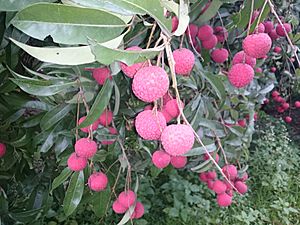
There are many different types of lychee trees, known as cultivars. It can sometimes be confusing to tell them apart because the same type of lychee might produce different fruit if grown in a different climate. Also, some cultivars have different names in different parts of the world. Countries in Southeast Asia and Australia often use the original Chinese names for the main types. India grows more than a dozen different cultivars. In South Africa, the "Mauritius" cultivar is very popular. Most of the lychee types grown in the United States came from China, except for one called "Groff," which was developed in Hawaii.
Different lychee cultivars are popular in different places. In China, some popular types include Sanyuehong, Feizixiao, and Nuomici. In Vietnam, the most popular type is Vai thieu Hai Duong. In Florida, people grow Mauritius, Brewster, and Hak Ip lychees. India has many named types, like Shahi and Rose Scented.
Images for kids
-
Lychee fruits at a market in West Bengal, India.
See also
 In Spanish: Lichi para niños
In Spanish: Lichi para niños


